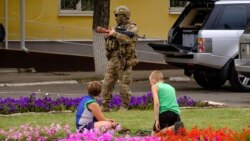Good morning,
Here are a few of the things that caught our attention in recent hours:
And there's also this from the spokeswoman for the Ukrainian Foreign Ministry:
We are now closing the live blog for today, but we will be back again with all the latest developments tomorrow morning. Until then, you can catch up with all our other Ukraine coverage here.
And, here's a transcript of RFE/RL correspondent Rikard Jozwiak's interview with Alexander Hug, the first deputy head of the OSCE's Special Monitoring Mission to Ukraine (edited slightly for length and clarity):
RFE/RL: What is the latest situation right now at the line of contact and what is the amount of cease-fire violation?
Th OSCE Special Monitoring Mission has seen in the end of August high numbers of cease-fire violations all along the contact line concentrated around the known hot spots, of which [there] is one around the airport of Donetsk, [and] one further down to the east and north of Mariupol.
And then, in Minsk, the sides agreed to recommit to the cease-fire and, overnight, the cease-fire violations dropped to almost zero for a couple of days, if not a week. Now we have seen again an increase in these violations and we are back in the numbers of 800, 900, even in the thousands on a daily basis.
More worrying is that a rather large percentage of these violations are consisting of explosions, which is an indication of the use of heavy weapons. These are the weapons that should be long removed and should have been taken behind withdrawal lines as agreed in [the] Minsk agreements.
RFE/RL: When you said there are lot of violations can you specify in percentage terms how many violations are coming from each side?
The OSCE Special Monitoring Mission does not finger point in terms of speculative reporting. Where we see that a certain fire came from one side, we describe it as such. If you read our report, you can see that we document exchanges of fires with our cameras. We can clearly say that shots have been fired from the east to the west and responded by [forces positioned in the] west to the east. Where we can't do that,we don't do it.
What is a fact is that both sides violate Minsk...Both sides do that on a regular basis with all types of weapons, including those that are proscribed in Minsk
RFE/RL: How well can you monitor the border between Russia and Ukraine?
The mandate of the OSCE Special Monitoring Mission extends to all of Ukraine, including all of the areas not controlled at the moment by the government in the eastern part of the country.
That includes the zone along the almost 400-kilometer stretch of border currently not controlled by the government. There, the OSCE Special Monitoring Mission conducts patrols on a regular basis to the former border control posts there. We manage to reach those border control posts but often our monitoring activities there are restricted. The patrols are being sent back and, of course, until we reach these borders areas we have to pass through several check points...
RFE/RL: Can you please explain a bit about the humanitarian situation along the contact line?
The line of contact leads though heavily built up areas. Just look at the city of Donetsk. The whole western part and northwestern part of Donetsk city is at the moment on the contact line. It leads then further to the northeast, toward the western outskirts of Horlivka and other heavily built up areas. These areas are still inhabited. People there go about their normal lives. They go to school, they go to work, they go to study, they go and visit their friends. Military positions are intermingled within these civilian buildings.
Now, positions normally draw counterfire and that is why we have always called on the sides to stop putting military hardware and positions near civilian infrastructure because unavoidably this draws counterfire -- and counterfire is often indiscriminate and hits civilians' buildings and injures and kills civilians [who are] in the way.
RFE/RL: What would you say are the biggest impediments to the OSCE mission functioning properly?
Security is the biggest concern for a civilian, unarmed observer mission. Our monitors are being hindered by armed men or Ukrainian armed forces in doing their work.
Looking back between April and mid-October, 70% of the freedom-of-movement restrictions occurred in areas not controlled by the government.
This happens in different fashions. We are either stopped and blocked from proceeding further, we can only continue further under certain conditions, or we are delayed for hours at a certain checkpoint before we then can go further.
All of those violations are, on the one hand, interference in our mandate, but also violations of Minsk.
It doesn't stop there. Also the technology that we use is interfered with. Our unmanned aerial vehicles (UAVs) are electronically interfered with; they are shot at. Our cameras are dismantled or sabotaged and our mini-UAVs that we are flying there are being shot at by small arms fire from the ground, not only endangering the pilot but, of course, damaging the technology that is used to overcame the gap that is left there by the inability of our monitors to reach certain areas.
RFE/RL: Are both sides engaging in this type of sabotage?
We have incidents that affect our UAVS on both sides of contact line. What is important is that each of these incidents must be followed up on by those who have effective control. Impunity for these instances is an open invitation for those on the ground to commit more because they don't fear any consequences of interfering with our activities on the ground.




